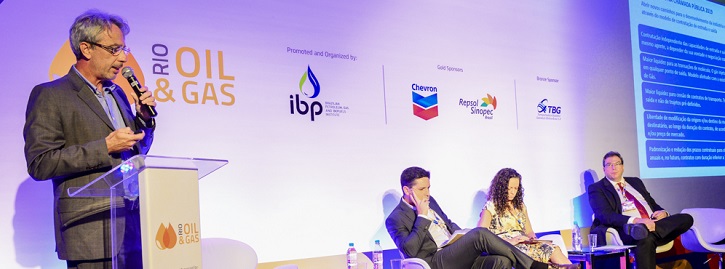Na Rio Oil & Gas, Petrobras diz que campo do pré-sal já produz o mesmo que Colômbia

Parceria e divisão de riscos foi fundamental para o sucesso
Rio de Janeiro, 26 de setembro – O gerente geral de gestão de contratos de produção da Petrobras, Daniel Pedroso, afirmou nesta quarta-feira, na Rio Oil & Gas 2018, que a parceria formada há 18 anos para o desenvolvimento do bloco BM-S-11, na Bacia de Santos, onde está o campo de Lula, foi fundamental para o desenvolvimento do que hoje representa a maior produção em área ultra profunda do mundo.
“Tínhamos uma área classificada como de extremo risco, com sísmica questionável, custo de desenvolvimento inviável. As três empresas se reuniram e a redução de risco foi preponderante naquele momento. A atividade em parceria tem sido o foco da companhia, que está priorizando a redução de riscos”, explicou o executivo da Petrobras durante uma sessão especial sobre “Parcerias entre grandes operadoras em mega projetos do pré-sal”.
O bloco foi licitado na Rodada 2, da Agência Nacional do Petróleo, Gás e Biocombustíveis (ANP), e o consórcio vencedor reuniu Petrobras (65%), BG (25%) e Petrogal (10%). Atualmente, inclui a Shell, após a compra da BG pela operadora anglo holandesa. Ao todo, o campo de Lula tem 133 poços que produzem 829 mil barris por dia.
“Esse consórcio tem o nível de produção de um país como a Colômbia, e ainda não terminamos o desenvolvimento. Já atingimos 1 bilhão de barris. Esperamos chegar a 1 milhão de barris por dia. Temos pelo menos mais duas décadas de uma história de sucesso para contar”, destacou Pedroso.
O campo de Lula possui ainda área de Iara, onde foi perfurado o poço com recorde mundial em espessura, com 580 metros, em consórcio com a francesa Total. Durante o almoço-palestra na Rio Oil & Gas, Arnaud Breuillac, presidente de E&P da Total, falou da relevância do pré-sal brasileiro para o portfólio da companhia, que se tornou, neste ano, a primeira operadora da região, com a aquisição do campo de Lapa.
“Esperamos aumentar significativamente a produção de barris de petróleo equivalente por dia nos ativos da Total no pré-sal brasileiro até 2022. Avaliamos que a exploração em ultraprofundas, seja no Brasil ou em outras localidades do mundo, é extremamente competitivo”, afirmou Breuillac.
Desenvolvimento Onshore
Além do pré-sal, a Rio Oil & Gas abriu espaço para discussões sobre o desenvolvimento das bacias terrestres. Em painel no Fórum Onshore, um dos eventos paralelos da programação, o secretário de petróleo e gás do Ministério de Minas e Energia, João Vicente, chamou atenção para o potencial e a necessidade do desenvolvimento de campos maduros no país.
“O país tem um potencial gigantesco e não pode se furtar de desenvolver esses recursos ou pelo menos debater se vai desenvolver esses recursos. Um ponto fundamental para o desenvolvimento da indústria é o programa de desinvestimento da Petrobras. Outro ponto são as ofertas permanentes, que é uma oportunidade ímpar para os novos players com apetite ao risco e que conseguem mobilizar capital para risco”, informou.
O diretor da ANP, Dirceu Amorelli, pontuou que as ações da ANP são focadas na adequação da regulação de cada ambiente e em revitalizar o movimento de declínio acentuado dos campos.
Refino
Nos últimos dois anos, a indústria de petróleo brasileira voltou a chamar a atenção e a atrair investimentos, criando a necessidade de se colocar na mesa discussões sobre as possibilidades para avançar a área de refino. Além disso, o segmento tem grande potencial no país, conforme destacou Arlindo Moreira Filho, gerente geral de programas de reestruturação de negócios do RGN na Petrobras, durante a sessão especial “Uma avaliação das oportunidades no segmento de refino do Brasil”.
“O Brasil é o sétimo maior consumidor de derivados de petróleo do mundo e a tendência é de crescimento, ao contrário de mercados maduros. Para atrair novos investimentos nessa área, no entanto, é preciso ações, como a garantia da estabilidade regulatória e fiscal, o combate a fraudes e a harmonização das cadeias de biocombustíveis e dos combustíveis fósseis”, ressaltou.
Sobre a política de preços de derivados, Décio Oddone, diretor-geral da ANP, foi enfático sobre a necessidade de maior transparência. “Hoje, não há transparência em como esses preços são formados. É essencial que os preços reflitam o mercado internacional e os custos de operação no Brasil para que seja possível atrair investimentos e gerar competição”, explicou. “Apenas um mercado aberto, dinâmico e competitivo, com pluralidade de agentes, possibilitará o aumento da produção doméstica e redução da dependência das importações”, acrescentou.
Atração e retenção de talentos
O futuro da indústria de óleo e gás, a necessidade de modernidade nas áreas de Recursos Humanos das empresas e a redução do interesse dos jovens em atuar na indústria também foi tema de debate nesta quarta-feira, na Rio Oil & Gas.
Tatiana Mey, estudante do MIT, apresentou uma visão internacional do cenário, e contou um pouco da sua experiência no exterior, fazendo uma comparação como Brasil. “Os jovens no Brasil acreditam que essa é uma indústria old fashion, ultrapassada e são imediatistas. Eles têm muita vontade de empreender e trabalhar em uma empresa que dê oportunidade de liderança, que realmente acredite na meritocracia”.
De acordo com a estudante, é possível notar uma mudança desse setor nos EUA na forma de se comunicar. Tatiana ponderou que a indústria do Brasil está começando a se modernizar e citou a campanha “Além da superfície”, liderada pelo IBP, além da iniciativa em promover a Oil & Gas Techweek, com foco nas tecnologias digitais.
A programação completa da Rio Oil & Gas pode ser acessada no portal www.riooilgas.com.br ou pelo App, disponível para download na Google Play ou na App Store.
A Rio Oil & Gas 2018 é patrocinada pela Petrobras, BP, Modec, Shell, Suatrans, Total, Santander, Chevron, Dow Química, Equinor, ExxonMobil, Galp, Repsol Sinopec, Misc Group, PetroRio, BakerHughes, Braskem, Fluor, Ipiranga, Microsoft, Plural, Porto do Itaqui, QGEP, Raízen, S&P Global Platts Thomson Reuters, Sulzer, Rosneft, TBG, Vallourec e WeWork.